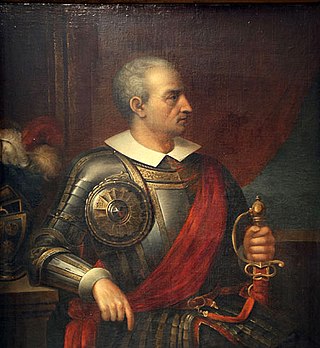
Diego de Almagro, also known as El Adelantado and El Viejo, was a Spanish conquistador known for his exploits in western South America. He participated with Francisco Pizarro in the Spanish conquest of Peru. While subduing the Inca Empire he laid the foundation for Quito and Trujillo as Spanish cities in present-day Ecuador and Peru, respectively. From Peru, Almagro led the first Spanish military expedition to central Chile. Back in Peru, a longstanding conflict with Pizarro over the control of the former Inca capital of Cuzco erupted into a civil war between the two bands of conquistadores. In the battle of Las Salinas in 1538, Almagro was defeated by the Pizarro brothers and months later he was executed.
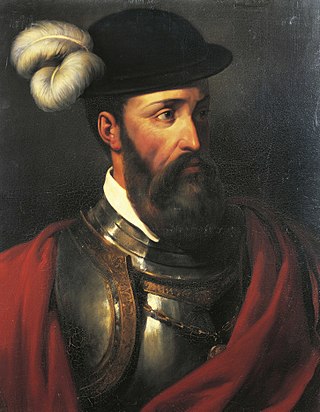
Francisco Pizarro, Marquess of the Atabillos was a Spanish conquistador, best known for his expeditions that led to the Spanish conquest of the Inca Empire.

Gonzalo Pizarro y Alonso was a Spanish conquistador. He was the younger paternal half brother of Francisco Pizarro, who led the Spanish conquest of the Inca Empire. Pizarro was the illegitimate son of Gonzalo Pizarro y Rodríguez de Aguilar (1446–1522), who, as an infantry colonel, served under Gonzalo Fernández de Córdoba during the Italian Wars. He was also the younger paternal half brother of Hernándo Pizarro y de Vargas and the older paternal full brother of Juan Pizarro y Alonso.
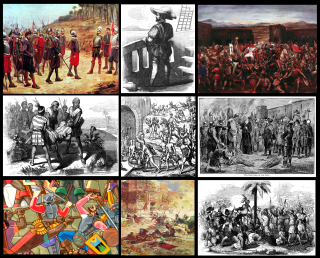
The Spanish conquest of the Inca Empire, also known as the Conquest of Peru, was one of the most important campaigns in the Spanish colonization of the Americas. After years of preliminary exploration and military skirmishes, 168 Spanish soldiers under conquistador Francisco Pizarro, along with his brothers in arms and their indigenous allies, captured the Sapa Inca Atahualpa in the 1532 Battle of Cajamarca. It was the first step in a long campaign that took decades of fighting but ended in Spanish victory in 1572 and colonization of the region as the Viceroyalty of Peru. The conquest of the Inca Empire, led to spin-off campaigns into present-day Chile and Colombia, as well as expeditions to the Amazon Basin and surrounding rainforest.

Manqu Inka Yupanki (Quechua) was the founder and monarch of the independent Neo-Inca State in Vilcabamba, although he was originally a puppet Inca Emperor installed by the Spaniards. He was also known as "Manco II" and "Manco Cápac II". He was one of the sons of Huayna Capac and a younger brother of Huascar.
The Pizarro brothers were four Spanish conquistador brothers who came to Peru in 1530. They all were born in Trujillo, Spain. Only one of the brothers, Hernando Pizarro, was a legitimate child of Captain Gonzalo Pizarro y Rodríguez. The four brothers were:
Juan Pizarro y Alonso was a Spanish conquistador who accompanied his brothers Francisco, Gonzalo and Hernando Pizarro for the conquest of Peru in 1532.

Francisco de Carvajal was a Spanish military officer, conquistador, and explorer remembered as "the demon of the Andes" due to his brutality and uncanny military skill in the Peruvian civil wars of the 16th century.
The Battle of Las Salinas was a military conflict and decisive confrontation between the forces of Hernando and Gonzalo Pizarro against those of rival conquistador Diego de Almagro, on April 6, 1538, during the Conquest of Peru. Both camps claimed to represent the authority of the Spanish Crown; Pizarro's forces controlled the province of Nueva Castilla, and those of Almagro, Nueva Toledo.
Hernando Pizarro y de Vargas was a Spanish conquistador and one of the Pizarro brothers who ruled over Peru.
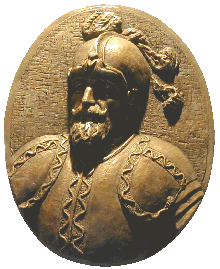
Alonso de Alvarado Montaya González de Cevallos y Miranda (1500–1556) was a Spanish conquistador and knight of the Order of Santiago.
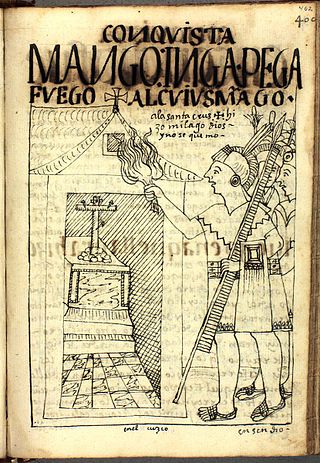
The 10-month siege of Cusco by the Inca army under the command of Sapa Inca Manco Inca Yupanqui started on 6 May 1536 and ended in March 1537. The city was held by a garrison of Spanish conquistadors and Indian auxiliaries led by Hernando Pizarro. The Incas hoped to restore their empire (1438–1533) with this action, but it was ultimately unsuccessful.
Rodrigo Orgóñez was a Spanish captain under Diego de Almagro, a conquistador known for his exploits in western South America.

Pawllu Inka Tupaq was a puppet Sapa Inca installed by the Spaniards after the previous Sapa Inca, Manco Inca Yupanqui, rebelled against the Spanish and established the small Neo-Inca State in Vilcabamba.

The Battle of Jaquijahuana was fought between the forces of Gonzalo Pizarro and Pedro de la Gasca, on April 9, 1548, during the Revolt of the Encomenderos by the Spanish conquistadores.
After his unheard claims as governor of New Castile (Peru) following the death of his brother, Gonzalo Pizarro pressed claims to be recognized as the ruler of the land he and his brothers had conquered. After the arrival of appointed royal viceroy Blasco Núñez Vela in 1544, Gonzalo succeeded to have him repelled and sent to Panama in chains. He was released, however, and returned to Peru by sea while Gonzalo was mustering an army. The two met on January 18 at Iñaquito in the outskirts of Quito, present-day capital of Ecuador, where the superiority of the Nueva Castilla army ensured victory for Gonzalo. Blasco Núñez Vela reportedly fought but fell as a victim in battle and was later decapitated on the field of defeat, a fate Gonzalo himself would share two years later at Jaquijahuana.
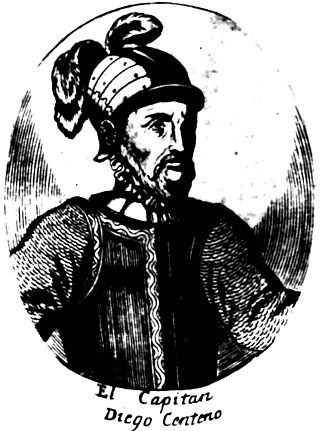
Diego Centeno was a Spanish conquistador. He arrived to South America and the recently conquered Inca Empire in 1534 at the age of 20, followed by, among others, Pedro de Alvarado, conqueror of Guatemala. In the ensuring battles between the Pizarro brothers and the Almagristas led by Diego de Almagro and, after his defeat and execution in 1538, by his son, Centeno took the party of Pizarro and New Castile. After the downfall of both parties, Diego fought with the Spanish royal forces of Pedro de la Gasca after the defeat and death of Blasco Núñez Vela on the hands of Gonzalo Pizarro. He was defeated in the battle of Huarina by Francisco de Carvajal but managed to reunite with de la Gasca and defeat the forces of Gonzalo and de Carvajal in the battle of Jaquijahuana.
After sending away royal appointed governor of the Viceroyalty of Peru, Blasco Núñez Vela and later defeating and killing him in the battle of Añaquito, Gonzalo Pizarro assembled an army of 1,200 men to press claims for the rule over Peru, once belonging to him and his brothers. The new viceroy, Pedro de la Gasca, landed in Peru in 1547, and a contingent of his troops, led by Diego Centeno, was severely defeated at Huarina by Francisco de Carvajal
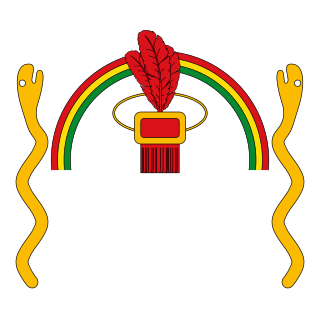
The Neo-Inca State, also known as the Neo-Inca state of Vilcabamba, was the Inca state established in 1537 at Vilcabamba by Manco Inca Yupanqui. It is considered a rump state of the Inca Empire (1438–1533), which collapsed after the Spanish conquest in the mid-1530s. The Neo-Inca State lasted until 1572, when the last Inca stronghold was conquered, and the last ruler, Túpac Amaru, was captured and executed, thus ending the political authority of the Inca state.
Gómez de Alvarado y Contreras was a Spanish conquistador and explorer. He was a member of the Alvarado family and the older brother of the famous conquistador Pedro de Alvarado.











